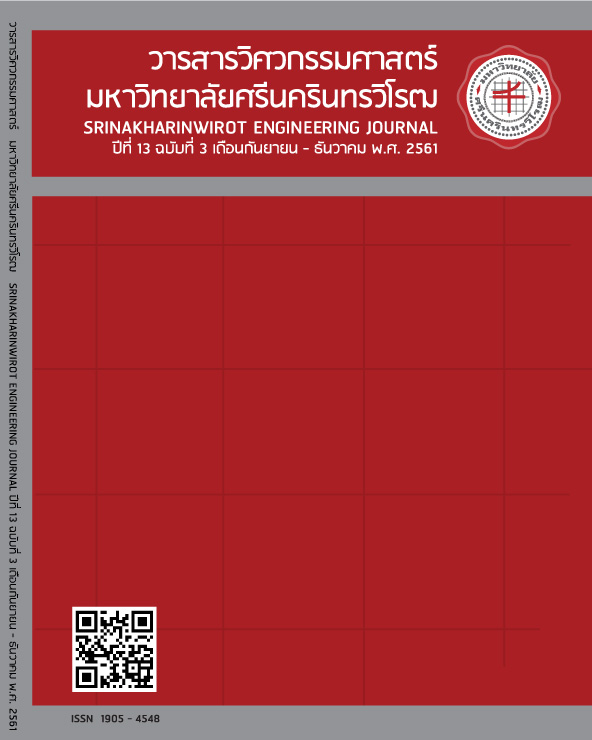Application of Surface Modification by Shot Peening for Improving Adhesive Wear Resistance in Ironing of Aluminum Alloy Cup
Main Article Content
Abstract
The aim of this research is to improve adhesive wear resistance in ironing of aluminum alloy cups by utilizing modification of the die surface with shot peening and post-polishing. The dies were made of TiCN-based cermet with three different surface conditions, polished, shot-peened (Ra = 0.08 ~ 0.10 µm) and shot-peened (Ra = 0.14 ~ 0.18 µm) surfaces. Workpiece material was aluminum alloy A3003-O sheets. The aluminum alloy sheets were formed into cups by a deep drawing process. Before ironing, liquid lubricant was applied onto the die and cup surfaces. The ironing ratio was changed to accelerate occurrence of adhesive wear. The results showed that comparing to the smooth polished die, the shot-peened die (Ra = 0.08 ~ 0.10 µm) succeeded in ironing cups at a high ironing ratio without adhesion of the cup material on the die. The adhesive wear resistance was improved because dimples on the surface structured by shot peening helped retaining and supplying the lubricant into the die-cup interface during the ironing.
Article Details
Copyright belongs to Srinakharinwirot University Engineering Journal
References
[2] P. Groche, G. Nitzsche and A. Elsen, “Adhesive wear in deep drawing of aluminum sheets,” CIRP Ann. Manuf. Technol., vol. 57, pp. 295–298, May 2008.
[3] N. Bay, A. Azushima, P. Groche, I. Ishibashi, M. Merklein, M. Morishita, T. Nakamura, S. Schmid and M. Yoshida, “Environmentally benign tribo-systems for metal forming,” CIRP Ann. Manuf. Technol., vol. 59, pp. 760–780, Jul. 2010.
[4] T. Mizuno and M. Okamoto, “Effects of lubricant viscosity at pressure and sliding velocity on lubricating conditions in the compression-friction test on sheet metals,” Trans. ASME J. Lubr. Technol., vol. 104, pp. 53–59, Jan. 1982.
[5] H. Kudo, M. Tsubouchi, H. Takada and K. Okamura, “An investigation into plasto-hydrodynamic lubrication with a cold sheet drawing test,” CIRP Ann. Manuf. Technol., vol. 31, pp. 175–180, Jan. 1982.
[6] A. Azushima, M. Uda and H. Kudo, “An interpretation of the speed dependence of the coefficient of friction under the micro-PHL condition in sheet drawing,” CIRP Ann. Manuf. Technol., vol. 40, pp. 227–230, Jan. 1991.
[7] A. Azushima, “Direct observation of contact behaviour to interpret the pressure dependence of the coefficient of friction in sheet metal forming,” CIRP Ann. Manuf. Technol., vol. 44, pp. 209-212, Jan. 1995.
[8] K. Steinhoff, W. Rasp and O. Pawelski, “Development of deterministic- stochastic surface structures to improve the tribological conditions of sheet forming processes,” J. Mater. Process. Technol., vol. 60, pp. 355-361, Jun. 1996.
[9] M. Vermeulen and J. Scheers, “Micro-hydrodynamic effects in EBT textured steel sheet,” Int. J. Mach. Tools Manuf., vol. 41, pp. 1941-1951, Oct. 2001.
[10] M. S. Nilsson, DD. Olsson, I. Petrushina, J. L. Andreasen, N. Bay, E. Christensen and N. J. Bjerrum, “Strategic surface topographies for enhanced lubrication in sheet forming of stainless steel,” Int. J. Surf. Sci. Eng., vol. 4, pp. 68-79, Jan. 2010.
[11] M. Geiger, U. Popp and U. Engel, “Excimer laser micro texturing of cold forging tool surfaces - influence on tool life,” CIRP Ann. Manuf. Technol., vol. 51, pp. 231-234, Jul. 2002.
[12] U. Popp and U. Engel, “Microtexturing of cold-forging tools-influence on tool life,” Proc. Inst. Mech. Eng. Part B J. Eng. Manuf., vol. 220, pp. 27-33, Jan. 2006.
[13] K. Lawanwong, B. Sresomroeng and V. Premanond, “The study type of hard film coating and strength of materials to wear volume by ball-on-disk technique,” R&D J. Eng. Inst. Tha., vol. 20, No. 4, pp. 84-91, Aug. 2009. [in Thai]
[14] P. Chumrum, V. Premanond and K. Lawanwong, “Application of surface modification for extension tool life in blanking process,” J. Indus. Tech., vol. 12, no. 1, pp. 13-27, 2016. [in Thai]
[15] P. Basnyat, B. Luster, C. Muratore, A.A. Voevodin, R. Haasch, R. Zakeri, P. Kohli and S.M. Aouadi, “Surface texturing for adaptive solid lubrication,” Surf. Coat. Technol., vol. 203, pp. 73-39, Oct. 2008.
[16] A. Khantachawana. (2018, July 6). Smart orthopedic fixation - NSTDA investors’ day 2018 [in Thai]. [Online]. Available: https://www.nstda.or.th/investorsday/2018/projects/detail/13/index.html.
[17] M. Aramaki, N. Yamada and O. Furukimi, “Effect of combined shot treatment and nitriding on galling property of die used for high strength steels,” ISIJ Int., vol. 51, pp. 1137-1141, Jul. 2011.
[18] J. Bech, N. Bay and M. Eriksen, “Entrapment and escape of liquid lubricant in metal forming,” Wear, vol. 232, pp. 134-139, Oct. 1999.


